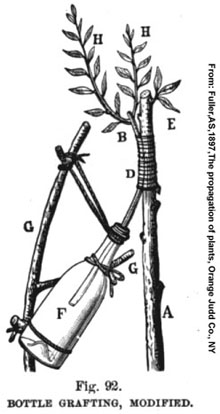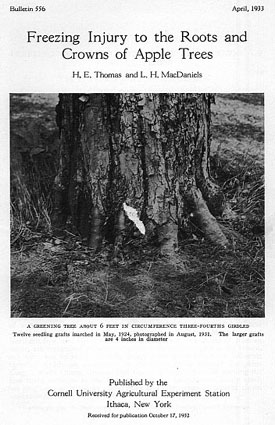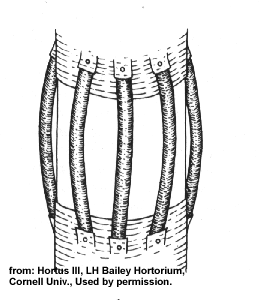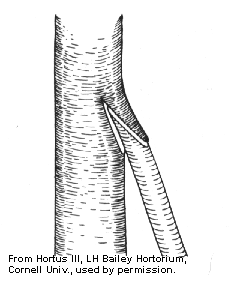>> Approach Grafting and Inarching
|
An artificial "hedge"
created for demonstration purposes by approach grafting several containerized
Inga fueillia.
|
|
Application: Approach grafting and inarching are similar in that both involve the use of a scion which is still attached to its own root system at the time of grafting. In fact the two terms are sometimes used interchangeably. Both share this feature (attached scion) with natural grafting, and are likely to have been the first attempts at grafting by early agriculturists. Unlike "detached" scion grafting (i.e. all other methods), the scion is less likely to become water stressed, resulting in a high probability of success. Although the two methods are similar with respect to the "attached sicon" feature, they are used quite differently. Approach grafting is usually practiced for propagation of fruit trees like mango, and tamarind, resulting in a reproductively mature scion (that would otherwise be difficult to clone) on a seedling rootstock. Inarching, on the other hand is used to replace the root system of an established tree for a variety of reasons such as girdling of the original trunk, a delayed graft incompatibility freezing injury, or root system disease or pest problem. The later assumes that the new root system is resistant. Both Approach grafting and Inarching usually involve large plants growing in the field. The two methods differ in that approach grafting usually involves a stock plant with its root stystem in a small container that is tied up against the scion donor plant, often well up in the canopy of a mature tree. Inarching one the other hand involves one or more stock plants that are deliberately planted in the ground at the base of an established tree. |
|
| For approach grafting, the goal is usually to graft a scion from a mature intact tree onto a smaller rootstock with its own rootsystem in some sort of container tied up into the canopy of the scion donor tree. | |
|
An older variation on approach grafting, called bottle grafting, was intended to use the established tree as the under stock, as a means of topworking. This would be similar to one of the more common top grafting methods like cleft grafting, except that the detatched scion, was provided with a source of water, by placing its cut end in a bottle of water. The bottle was tied up into the canopy of the established understock tree. |
 |
|
Inarching
of an established apple tree with several seedlings planted at regular
intervals around the base.
|
 |
|
Timing:Approach grafting of tropical fruit trees is practiced more or less any time as long as the containerized root system can be kept well watered. Inarching, on the other hand often involves planting the new rootstock seedlings at the base of an established tree in the spring, and allowing them to become established for several weeks or months before grafting later during the growing season. |
|
|
How to Approach Graft and Inarching: |
|
|
Inarching and
/ or approach grafting can be performed either with a rind grafting method,
such as the bark graft used to make the bridge graft shown here.
Bridge grafting is not an example of inarching or approach grafting, per
se, but it does illustrate the use of a bark graft, in which the rind
or bark must be peeled back in order to place the stock (or in this case
interstock) against the underlying wood of the scion.
|
 |
| Alternatively inarching or approach grafting may involve a side graft, which involves cutting through the bark and into the underlying wood, for placement of the stock. |  |
| Another non rind method is splice approach grafting. A splice approach involves cutting away a portion of bark and underlying wood to expose the cambium of stock and scion, and tying these together. | |
|
A cleft approach
graft involves inserting the tip of the stock is into a split cut through
the bark and into the underlying wood of the scion donor branch. This
is an approach graft of Leucaena leucocephala / L. leucocephala.
|
|
|
After formation
of the graft union the new grafted plant is cut way from the scion donor
plant by cutting the scion donor branch below the union. This picture
was taken several month after the previous picture, and the stump below
the union was left deliberately long simply to show the original configuration.
|
|
Additional Information:
| Source:
Larry Stein, Texas Agricultural Extension Service Title: Approach Grafting URL: http://extension-horticulture.tamu.edu/propagation/approachgraft/approach.html Comments: |
| Source:
Texas A&M University,
Research and Extension Resource/Aggie Horticulture Title: Cleft Grafting URL: http://extension-horticulture.tamu.edu/propagation/cleftgrafting/cleftgrafting.html Comments: |